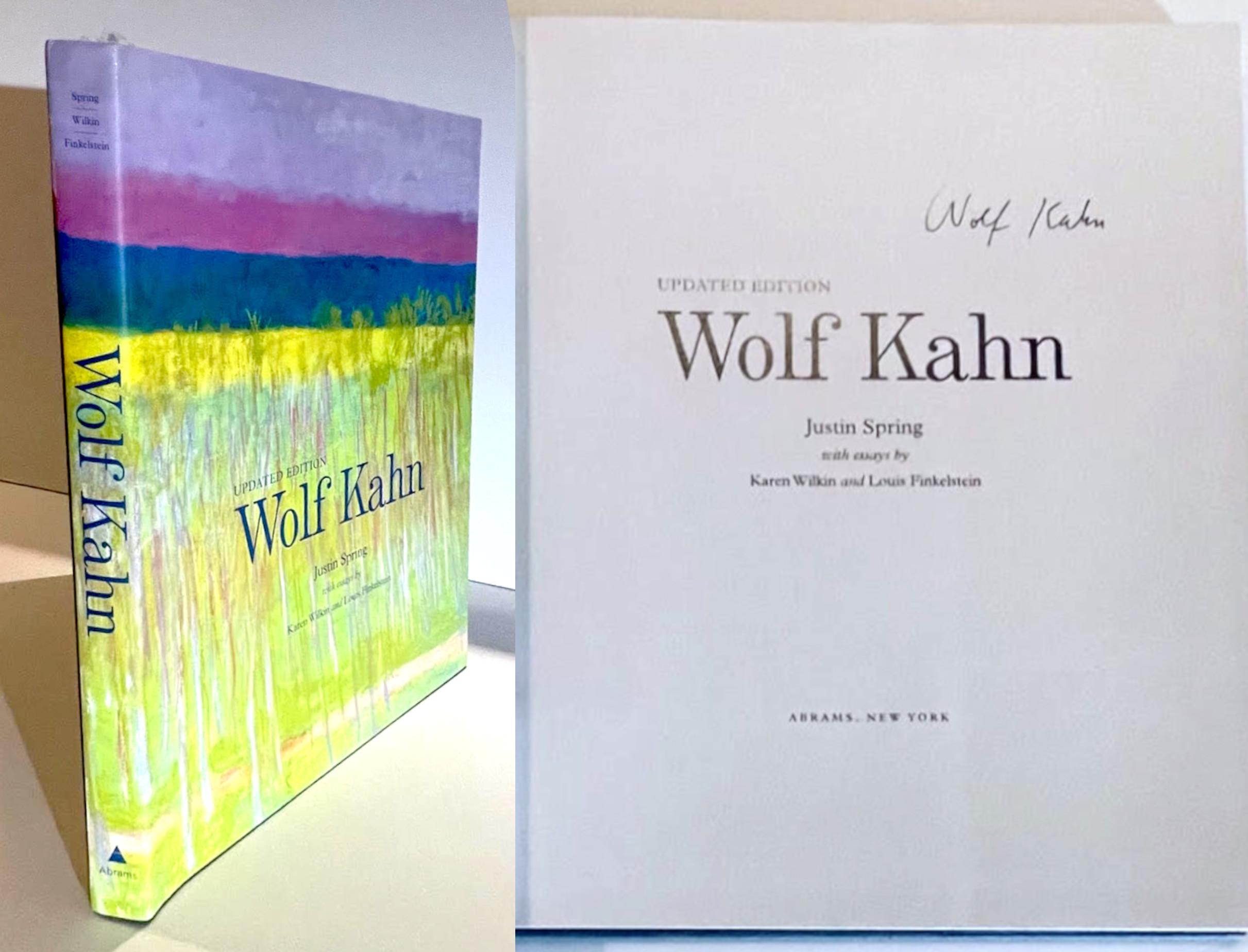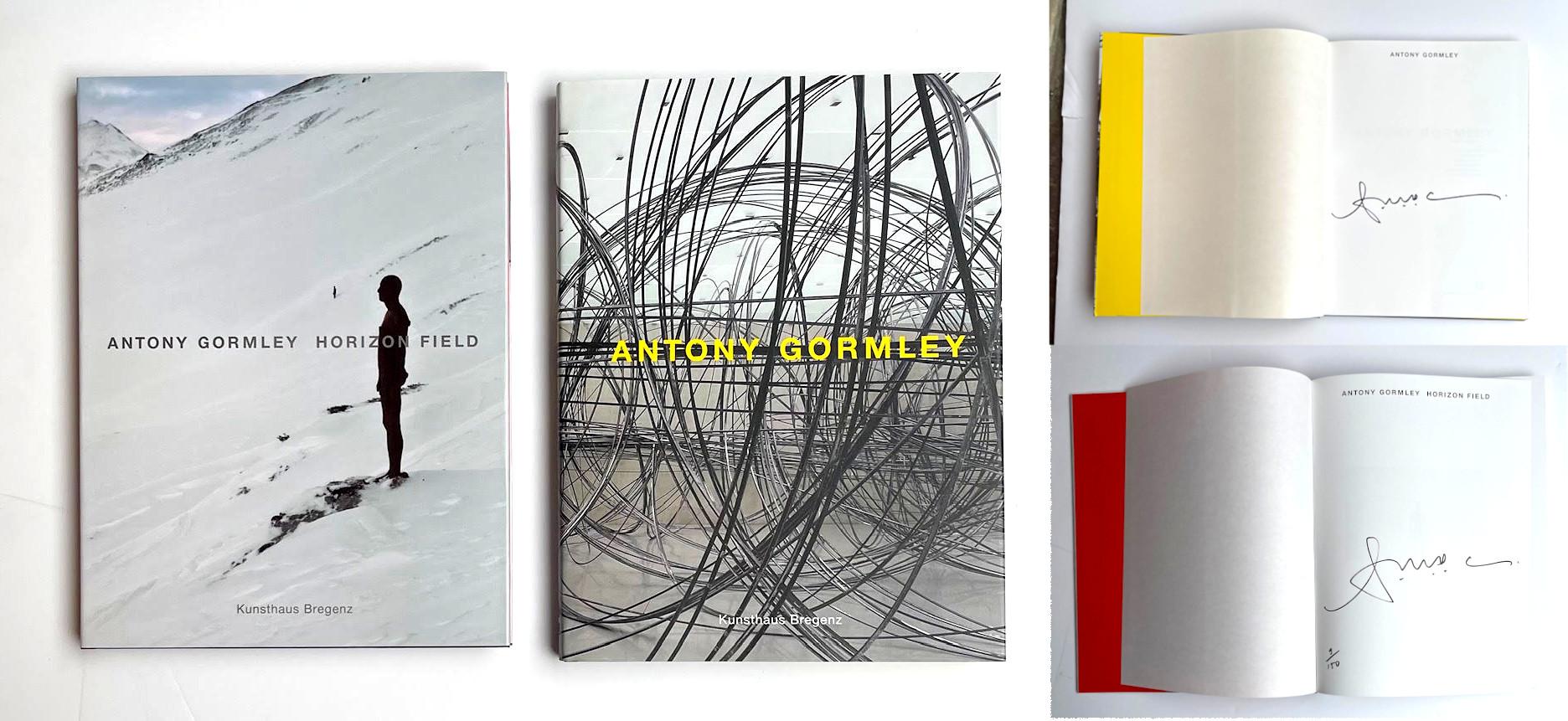Items Similar to Monograph: Being and Circumstance Notes Toward a Conditional Art (Hand signed)
Want more images or videos?
Request additional images or videos from the seller
1 of 17
Robert IrwinMonograph: Being and Circumstance Notes Toward a Conditional Art (Hand signed)1985
1985
About the Item
Robert Irwin
Being and Circumstance Notes Toward a Conditional Art, 1985
Hardback monograph with dust jacket (hand signed and dated 2015 by Robert Irwin)
Boldly signed and dated May 30 2015 by Robert Irwin on the title page
9 × 9 3/4 × 3/4 inches
Book information:
Publisher: Lapis Pr; First Edition (January 1, 1985)
Hardcover : 157 pages with color and bw illustrations
Boldly signed and dated May 30 2015 by Robert Irwin on the title page.
Publisher's blurb:
Robert Irwin, who is one of the most important artists of this era, was a seminal figure in "Light and Space" art. He began as an Abstract Expres sionist painter in the 1950s, and was for some time (but is no longer) an artist who produced no art objects. Irwin's philosophical and aesthetic theories are so far-reaching that only now, some twenty years after they were first posited, has the art world begun to recognize that his questions about perception come to bear upon the definition of art itself.
In the 1960s, his disc paintings succeeded in
"breaking the edge of the canvas," with the resultant effect that the space surrounding the work became equally important.
In the 1970s, Irwin created room-environment pieces of a phenomenal or non-object nature across the United States. Comprised solely of light, string, or nylon scrim, these works placed the responsibility upon the viewer in order to bring him to a position where he could "perceive himself perceiving"
"The Mondrian was no longer on the wall - the viewer was in the Mondrian."
In the last ten years, Irwin's sculptural aesthetic and his philosophical theories have merged to provide the impetus behind a major body of sculpture created in response to a specific site, situation, or locale.
Irwin's importance as an artist lies not only in the beauty and clarity of his precedent-setting work, but in his theoretical contribution, which provides a framework by which all phenomenal works can be examined.
This book, written by the artist, lays out his theoretical position and documents the working processes behind seventeen major sculpture projects created over the past decade.
Robert Irwin grew up and matured as an artist in Los Angeles. In 1984 he was the recipient of a MacArthur Foundation Fellowship.
More about Robert Irwin:
Robert Irwin is among the most significant American artists and theoreticians working today and is renowned for his innovative site-conditioned artworks that explore the effects of light through interventions in space and architecture.
Developing an Abstract Expressionist approach to painting by the late 1950s, Irwin had his first monographic exhibition at Felix Landau Gallery, Los Angeles, in 1957, then moving to the newly founded Ferus Gallery, where he began exhibiting in 1958. By the early sixties, Irwin shifted to creating more restrained works with his line paintings, guided principally by questions of structure, color, and perception, and his dot paintings, works on gently bowed supports composed with small dots of near-complementary colors. In 1966, Irwin initiated a series of curved aluminum and acrylic discs that he painted and displayed with an arm extending out from the wall, creating a viewing experience that is impossible for a work on canvas.
By 1970, Irwin abandoned his studio, embarking on an extended inquiry of artmaking beyond the frame and the traditional art object. Working in existing sites, he composes with materials that are ephemeral, but which substantially transform the viewers’ visual and phenomenological experience. Irwin’s interventions blur the distinctions between space and artwork, exploring the nature of light, volume, and perceptual psychology.
Irwin has created numerous permanent installations for museums and other public sites such as 1° 2° 3° 4° (1997) at the Museum of Contemporary Art San Diego, La Jolla, his first permanent museum installation. Framing an ocean view and literally opening up the gallery space to exterior light, air, smells, and sounds, 1° 2° 3° 4° exemplifies the subtle but dramatic transformations inherent to Irwin’s work. For its 125th anniversary, Indianapolis Museum of Art commissioned Light and Space III (2008) for its Pulliam Great Hall, a multifloored interior space in which the artist arranged fluorescent lights to create an irregular grid, flanked by semi-transparent fabric scrims.
Irwin has also created permanent site-conditioned landscape works, a facet of his practice initiated by his design of the Central Gardens at the J. Paul Getty Center, Los Angeles (1997). The Central Garden incorporates Irwin’s landscape design in accord with Richard Meier’s architecture and the ravine of its site, as well as layered combinations of plantings that juxtapose color, texture, and other sensory experiences with natural forms that vary over time.
Irwin’s large-scale permanent installation Untitled (dawn to dusk) opened in July 2016 at the Chinati Foundation in Marfa, Texas, occupying the site of a dilapidated former hospital building measuring approximately 10,000 square feet. Irwin designed the courtyard and divided the building’s interior into two halves—making one wing dark and the other light. With regularly spaced windows and scrims bisecting each side, the installation orchestrates viewers’ perceptions of light, interior space, and the surrounding landscape. The project, which was in development for fifteen years, is the first free-standing structure devoted exclusively to Irwin’s work. Over the past decade, Irwin has returned to his studio, using it as an experimental space to develop sculptural works with florescent lights and acrylic, such as his Sculpture/Configuration works exhibited at Pace in New York (2018), while continuing to develop his site-conditioned installations.
Irwin employs a wide range of media, from fluorescent lights to fabric scrims, colored and tinted gels, paint, wire, acrylic, and glass. He makes art that he considers “conditional,” responding to the context of its specific environment while displacing emphasis away from the materials themselves, however, drawing our attention to perception.
- Courtesy of Pace Gallery
- Creator:Robert Irwin (1928, American)
- Creation Year:1985
- Dimensions:Height: 9 in (22.86 cm)Width: 9.75 in (24.77 cm)Depth: 0.75 in (1.91 cm)
- Medium:
- Movement & Style:
- Period:
- Condition:Excellent with minor overall handling and age wear to the dust jacket but the inside pages, including the page with the artist's hand signature, are clean and crisp and fresh. NOT ex-library.
- Gallery Location:New York, NY
- Reference Number:1stDibs: LU1745213365392
About the Seller
5.0
Platinum Seller
These expertly vetted sellers are 1stDibs' most experienced sellers and are rated highest by our customers.
Established in 2007
1stDibs seller since 2022
289 sales on 1stDibs
Typical response time: 1 hour
- ShippingRetrieving quote...Ships From: New York, NY
- Return PolicyA return for this item may be initiated within 1 day of delivery.
More From This SellerView All
- Monograph: Robert Irwin Getty Garden (hand signed and inscribed by Robert Irwin)By Robert IrwinLocated in New York, NYRobert Irwin Getty Garden (hand signed and inscribed by Robert Irwin), 2002 Hardback monograph with dust jacket Hand signed and inscribed by Robert ...Category
Early 2000s Contemporary Landscape Prints
MaterialsPaper, Ink, Mixed Media, Lithograph, Offset
- Hardback monograph with dust jacket: Wolf Kahn (hand signed by Wolf Kahn)By Wolf KahnLocated in New York, NYWolf Kahn (hand signed by Wolf Kahn), 2011 Hardback monograph with dust jacket (hand signed by Wolf Kahn) Hand signed by Wolf Kahn on the title page 13 × 12 × 1 1/2 inches This gorge...Category
2010s Contemporary Landscape Prints
MaterialsInk, Offset, Lithograph, Mixed Media, Paper
- Wolf Kahn Pastels (monograph with slip case, hand signed and numbered)By Wolf KahnLocated in New York, NYWolf Kahn Pastels (monograph with slip case, hand signed and numbered), 2000 Hardback monograph with slipcase and dust jacket (hand signed and number...Category
Early 2000s Contemporary Landscape Prints
MaterialsPaper, Ink, Mixed Media, Lithograph, Offset
- Nine Swimming Pools and a Broken Glass (Hand signed by Ed Ruscha)By Ed RuschaLocated in New York, NYEd Ruscha Nine Swimming Pools and a Broken Glass (HAND SIGNED), 1976 Limited Edition Artist's Book Boldly signed by Ed Ruscha on the first front end page 7 × 5 1/2 inches This is the...Category
1970s Pop Art More Art
MaterialsLithograph, Offset, Ink, Mixed Media
- Antony Gormley Horizon Field (box set of two signed monographs held in slipcase)By Antony GormleyLocated in New York, NYAntony Gormley Horizon Field (box set of two signed monographs held in slipcase), 2011 Hardback monograph, numbered and each hand signed E...Category
2010s Contemporary Landscape Prints
MaterialsMixed Media, Lithograph, Offset
- William Eggleston The Democratic Forest Selected Works (Hand signed)By William EgglestonLocated in New York, NYWilliam Eggleston William Eggleston The Democratic Forest Selected Works (Hand signed), 2016 Hardback monograph with dust jacket Hand signed by William Eggleston...Category
2010s Modern More Art
MaterialsMixed Media, Lithograph, Offset
You May Also Like
- VeniceLocated in Miami, FLInspired by architecture, historical urbanism, passion for creation with intense multicultural experiences thru traveling and living in different parts of the planet, my drawings are...Category
2010s Contemporary Landscape Prints
MaterialsCanvas, Ink
- LondonLocated in Miami, FLMartin's vision of cities is cartographic. He is undoubtedly a man from another era - who likes the present - his plans of cities are an act of resistance in the era of google mapsCategory
2010s Contemporary Landscape Prints
MaterialsCanvas, Ink
- Michael Sanders, A Bracing Walk - Large Canvas Print, Seascape Art, Art OnlineBy Michael SandersLocated in Deddington, GBMichael Sanders A Bracing Walk Large Canvas Print Edition 50 Sold Unframed Limited edition canvas prints by Michael Sanders. These stunning prints are created using fine art archiva...Category
2010s Contemporary More Art
MaterialsCanvas, Archival Ink
- LondonLocated in Miami, FLMartin's vision of cities is cartographic. He is undoubtedly a man from another era - who likes the present - his plans of cities are an act of resistance in the era of google mapsCategory
2010s Contemporary Landscape Prints
MaterialsCanvas, Ink
- New YorkLocated in Miami, FLMartin's vision of cities is cartographic. He is undoubtedly a man from another era - who likes the present - his plans of cities are an act of resistance in the era of google mapsCategory
2010s Contemporary Landscape Prints
MaterialsCanvas, Ink
- GstaadLocated in Miami, FLInspired by architecture, historical urbanism, passion for creation with intense multicultural experiences thru traveling and living in different parts of the planet, my drawings...Category
2010s Contemporary Landscape Prints
MaterialsCanvas, Ink





